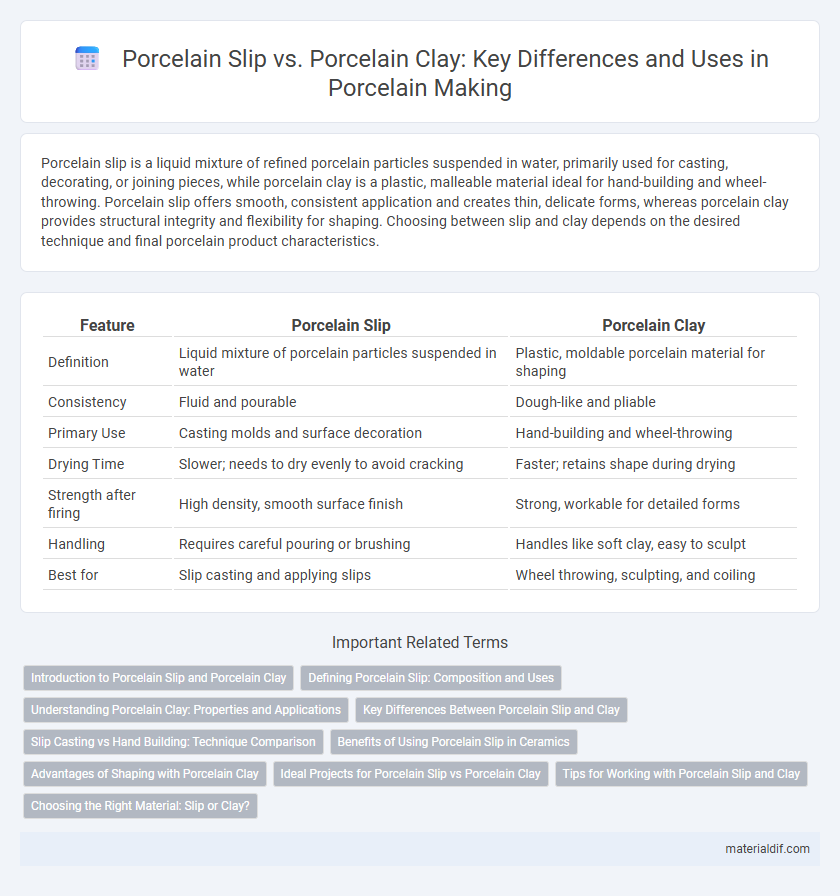Porcelain slip is a liquid mixture of refined porcelain particles suspended in water, primarily used for casting, decorating, or joining pieces, while porcelain clay is a plastic, malleable material ideal for hand-building and wheel-throwing. Porcelain slip offers smooth, consistent application and creates thin, delicate forms, whereas porcelain clay provides structural integrity and flexibility for shaping. Choosing between slip and clay depends on the desired technique and final porcelain product characteristics.
Table of Comparison
| Feature | Porcelain Slip | Porcelain Clay |
|---|---|---|
| Definition | Liquid mixture of porcelain particles suspended in water | Plastic, moldable porcelain material for shaping |
| Consistency | Fluid and pourable | Dough-like and pliable |
| Primary Use | Casting molds and surface decoration | Hand-building and wheel-throwing |
| Drying Time | Slower; needs to dry evenly to avoid cracking | Faster; retains shape during drying |
| Strength after firing | High density, smooth surface finish | Strong, workable for detailed forms |
| Handling | Requires careful pouring or brushing | Handles like soft clay, easy to sculpt |
| Best for | Slip casting and applying slips | Wheel throwing, sculpting, and coiling |
Introduction to Porcelain Slip and Porcelain Clay
Porcelain slip is a liquid suspension of finely ground porcelain clay particles in water, primarily used for casting and coating to achieve smooth, uniform surfaces in ceramic production. Porcelain clay, on the other hand, is the natural, plastic material composed mainly of kaolin, feldspar, and quartz, which artists and manufacturers shape and fire to create durable, translucent porcelain objects. Understanding the differences between porcelain slip and clay is essential for optimizing texture, workability, and final product quality in porcelain craftsmanship.
Defining Porcelain Slip: Composition and Uses
Porcelain slip is a liquid mixture of finely ground porcelain clay particles suspended in water, designed for casting and intricate decorating techniques. Its composition typically includes kaolin, feldspar, and quartz, finely ground to achieve a smooth consistency that allows for precise molding and slip trailing. Porcelain slip is ideal for creating detailed shapes, joining pieces, and surface decoration, offering greater versatility compared to solid porcelain clay.
Understanding Porcelain Clay: Properties and Applications
Porcelain clay is a refined, highly plastic material composed mainly of kaolin, feldspar, and quartz, designed for sculpting and forming durable ceramic pieces. Porcelain slip, a liquid suspension of porcelain clay in water, allows for casting complex shapes and fine details that are difficult to achieve with solid clay alone. Understanding the distinct properties of porcelain clay, such as its high firing temperature and translucency, is essential for selecting the appropriate medium in artistic and industrial applications.
Key Differences Between Porcelain Slip and Clay
Porcelain slip is a liquid mixture of fine porcelain particles suspended in water, primarily used for casting and decorating, offering smoother texture and finer detail control compared to porcelain clay. Porcelain clay, a solid, plastic material, contains a balanced blend of kaolin, feldspar, and silica, providing structural strength and workability for hand-building and wheel-throwing. Slip allows for seamless joining and surface decoration, while clay offers durability and shape stability during firing.
Slip Casting vs Hand Building: Technique Comparison
Porcelain slip, a liquid clay mixture, is essential for slip casting, allowing precise molds to be filled for intricate, uniform shapes, while porcelain clay's workable consistency suits hand building techniques like coiling and slab construction, offering greater tactile control and artistic freedom. Slip casting excels in producing thin-walled, finely detailed porcelain pieces with high repeatability, whereas hand building accommodates organic, unique forms that highlight the artist's individual touch. The choice between slip casting and hand building hinges on the desired finish, complexity, and production scale in porcelain artistry.
Benefits of Using Porcelain Slip in Ceramics
Porcelain slip offers exceptional fluidity, allowing for intricate detailing and smooth surface finishes that are difficult to achieve with traditional porcelain clay. Its fine particle size enhances workability and reduces drying cracks, leading to stronger and more durable ceramic pieces. Using porcelain slip also enables easier casting in molds, improving production efficiency and consistency in high-quality porcelain ceramics.
Advantages of Shaping with Porcelain Clay
Porcelain clay offers superior plasticity compared to porcelain slip, enabling more precise and intricate shaping of forms. Its cohesive texture allows artists to manipulate and mold without the risk of slippage or deformation during the forming process. This enhances control over fine details, making porcelain clay ideal for hand-building and wheel-throwing techniques.
Ideal Projects for Porcelain Slip vs Porcelain Clay
Porcelain slip is ideal for intricate decorative work, slip casting, and creating thin-walled vessels due to its fluid consistency and fine particle suspension. Porcelain clay, with its plasticity and strength, is best suited for hand-building, wheel-throwing, and functional ware like dinnerware and sculptural forms. Choosing slip or clay depends on project demands for detail, thickness, and structural integrity.
Tips for Working with Porcelain Slip and Clay
Porcelain slip, a liquid mixture of porcelain particles suspended in water, allows for seamless molding and intricate detailing, making it essential to keep the slip well-stirred and free of lumps for smooth application. Porcelain clay, in contrast, requires precise moisture control and gentle handling to prevent cracking during shaping and drying, with proper wedging techniques ensuring uniform consistency. Maintaining ideal moisture levels and using clean tools helps achieve the delicate translucency and strength that characterize fine porcelain pieces.
Choosing the Right Material: Slip or Clay?
Porcelain slip offers a liquid, easily moldable form ideal for detailed casting and joining in ceramics, while porcelain clay provides a more cohesive, plastic medium suited for hand-building and wheel-throwing techniques. Selecting between porcelain slip and clay depends on project requirements such as precision in shaping, surface finish, and drying times, with slip favoring intricate molds and clay supporting structural integrity. Understanding the physical properties of both materials ensures optimal results in porcelain craftsmanship, enhancing durability and aesthetic quality.
Porcelain slip vs Porcelain clay Infographic

 materialdif.com
materialdif.com